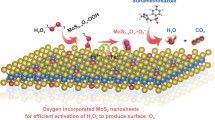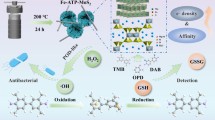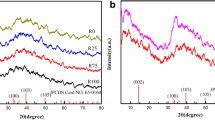Abstract
Nanozyme is a promising approach in treating pollution in drinking water sources. 2D MoS2 nanosheets, with abundant active sites and Lewis acid sites, exhibit outstanding peroxidase-like activity. Verified by density functional calculation, S vacancies in 2D MoS2 nanosheets can cleavage H2O to yield H+ and ·OH. The spontaneous generation of acid environment and oxygen free radicals enables 2D MoS2 nanosheets to be effectively exploited in the depuration of polluted water, creating a new era for multifunctional nanozymes.






Similar content being viewed by others
Availability of data and materials
No applicable.
References
J. Haseloff, W. Gerlach, Nature 334, 585 (1988)
M. Ridderström, B. Hubatsch, Biochem. J. 330, 175 (1998)
N. Gurung, S. Ray, S. Bose, V. Rai, Biomed. Res. Int. 2013, 329121 (2013)
L. Gao, J. Zhuang, L. Nie, J. Zhang, Y. Zhang, N. Gu, T. Wang, J. Feng, D. Yang, S. Perrett, X. Yan, Nat. Nanotechnol. 2, 577 (2007)
J. Wu, X. Wang, Q. Wang, Z. Lou, S. Li, Y. Zhu, L. Qin, H. Wei, Chem. Soc. Rev. 48, 1004 (2019)
H. Wei, E. Wang, Chem. Soc. Rev. 48, 1004 (2013)
Y. Zhou, B. Liu, R. Yang, J. Liu, Bioconjug. Chem. 28, 2903 (2017)
H. Wang, K. Wan, X. Shi, Adv Mater. 31, e1805368 (2019)
R. André, F. Natálio, M. Humanes, J. Leppin, K. Heinze, R. Wever, H.C. Schröder, W. Müller, W. Tremel, Adv. Funct. Mater. 21, 501 (2011)
Z. Wang, K. Dong, Z. Liu, Y. Zhang, Z. Chen, H. Sun, J. Ren, X. Qu, Biomaterials 113, 145 (2017)
J. Wang, Y. Wang, D. Zhang, C. Chen, Acs Appl. Mater. Inter. 12, 40990 (2020)
J. Zhang, J. Zhuang, L. Gao, Y. Zhang, N. Gu, J. Feng, D. Yang, J. Zhu, X. Yan, Chemosphere 73, 1524 (2008)
J. Jiang, Z. Chen, Y. Hu, Y.U. Xiang, L. Zhang, Y. Wang, G.C. Wang, J. Shi, Nat. Nanotechnol. 16, 894 (2021)
A. Abnavi, R. Ahmadi, H. Ghanbari, M. Fawzy, A. Hasani, T. Silva, A. Askar, M. Mohammadzadeh, F. Kabir, M. Whitwick, M. Beaudoin, S.O. Leary, M. Adachi, Adv. Funct. Mater. 33, 2210619 (2022)
L. Feng, L. Zhang, Y. Gong, Z. Du, X.I. Chen, X. Qi, X. Zhang, G. Mao, H. Wang, Sensor. Actuat. B Chem. 361, 131725 (2022)
H. Duan, C. Wang, G. Li, H. Tan, W. Hu, L. Cai, W. Liu, N. Li, Q. Ji, Y. Wang, Y. Lu, W. Yan, F. Hu, W. Zhang, Z. Sun, Z. Qi, L. Song, S. Wei, Angew. Chem. Int. Edit. 60, 251 (2021)
K. Qiu, W. Zou, Z. Fang, Y. Wang, S. Bell, X. Zhang, Z. Tian, X. Xu, B. Ji, D. Li, T. Huang, J. Diao, ACS Nano 17, 4716 (2023)
N. Pena, K. Cherukula, B. Even, D. Ji, S. Razafindrakoto, S. Peng, A. Silva, C. Moyon, H. Hillaireau, A. Bianco, E. Fattal, D. Alloyeau, F. Gazeau, Adv. Mater. 35, 2209615 (2023)
T. Lin, L. Zhong, L. Guo, F. Fu, G. Chen, Nanoscale 6, 11856 (2014)
H. Liu, B. Wang, D. Li, X. Zeng, X. Tang, Q. Gao, J. Cai, H. Cai, Microchim. Acta. 287, 185 (2018)
P. Borthakur, P. Boruah, M. Das, S. Artemkina, P. Poltarakcd, V. Fedorov, New J. Chem. 42, 16919 (2018)
W. Xia, P.U. Zhang, W. Fu, L. Hu, Y.I. Wang, Chem. Commun. 55, 2039 (2019)
J. Wang, Y. Wang, W. Ren, D. Zhang, P. Ju, K. Dou, J Hazard Mater. 440, 129742 (2022)
F. Tian, H. Zhang, S. Liu, T. Wu, J. Yu, D. Wang, X. Jin, C. Peng, Appl Catal B-Environ. 285, 119834 (2021)
M. Acerce, D. Voiry, M. Chhowalla, Nat Nanotechnol. 10, 313 (2015)
S.R. Ali, M. De, A.C.S. Appl, Nano Mater. 6, 2193 (2023)
H. Zhang, H. Lin, Y. Zheng, Y. Hu, A. MacLennan, Appl. Catal. B-Environ. 165, 537 (2015)
J. Ding, L. Huang, G. Ji, Y. Zeng, Z. Chen, E.G. Eddings, M. Fan, Q. Zhong, H.H. Kung, ACS Catal. 11, 5347 (2021)
Y. Wang, Y.I. He, R. Peng, S. Chu, Anal. Method. 9, 2939 (2017)
J. Yu, D. Ma, L. Mei, Q. Gao, W. Yin, X. Zhang, L. Yan, Z. Gu, X. Ma, Y. Zhao, J. Mater. Chem. B. 6, 487 (2018)
L. Gao, J. Zhuang, L. Nie, J. Zhang, Y.U. Zhang, N. Gu, T. Wang, J. Feng, D. Yang, S. Perrett, X. Yan, Nat. Nanotechnol. 2, 577 (2007)
Funding
This work was supported by the Natural Science Foundation of China (Grant No. 42176047), the Second Batch of Postdoctoral Funding in Qingdao in 2022, 2022 Special Research Assistant Program of the Chinese Academy of Science, and 73rd batch of general support from China Postdoctoral Science Foundation.
Author information
Authors and Affiliations
Contributions
JW was involved in writing—original draft, data curation, investigation and formal analysis. YW was responsible for conceptualization, supervision, writing—reviewing and editing, funding acquisition and data curation. WR contributed to resources and formal analysis. DZ participated in supervision and funding acquisition. PJ and KD assisted with software.
Corresponding author
Ethics declarations
Conflict of interest
There are no competing interests in this work.
Ethical approval
There is are human or animal studies in this work.
Additional information
Publisher's Note
Springer Nature remains neutral with regard to jurisdictional claims in published maps and institutional affiliations.
Supplementary Information
Below is the link to the electronic supplementary material.
Rights and permissions
Springer Nature or its licensor (e.g. a society or other partner) holds exclusive rights to this article under a publishing agreement with the author(s) or other rightsholder(s); author self-archiving of the accepted manuscript version of this article is solely governed by the terms of such publishing agreement and applicable law.
About this article
Cite this article
Wang, J., Ren, W., Wang, Y. et al. S vacancy in MoS2 nanosheets induces H2O cleavage: a new era for 2D nanozyme. Res Chem Intermed 49, 5541–5550 (2023). https://doi.org/10.1007/s11164-023-05135-y
Received:
Accepted:
Published:
Issue Date:
DOI: https://doi.org/10.1007/s11164-023-05135-y




